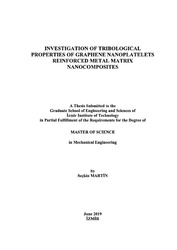Please use this identifier to cite or link to this item:
https://hdl.handle.net/11147/7471| Title: | Investigation of tribological properties of graphene nanoplatelets reinforced metal matrix nanocomposites | Other Titles: | Grafen nanolevha takviyeli metal matrisli nanokompozitlerin tribolojik özelliklerinin incelenmesi | Authors: | Martin, Seçkin | Advisors: | Kandemir, Sinan | Keywords: | Graphene nanoplatelets Reinforced metal matrix Tribological property Metal matrix composites |
Publisher: | Izmir Institute of Technology | Source: | Martin, S. (2019). Investigation of tribological properties of graphene nanoplatelets reinforced metal matrix nanocomposites. Unpublished master's thesis, İzmir Institute of Technology, İzmir, Turkey | Abstract: | In this research, graphene nanoplatelets (GNPs) with a thickness of 50-100 nm have been utilized to improve the mechanical and tribological properties of A360 alloy due to their extraordinary mechanical properties and solid lubricant nature. During the fabrication process, GNPs were introduced into the liquid Aluminum (Al), then mechanical stirrer and ultrasonic treatment were used to obtain homogeneous dispersion of GNPs throughout the matrix. The examination of microstructures showed that A360/0.25 wt.% GNP nanocomposites have a relatively uniform distribution of GNPs. During the tribological properties investigation, ball-on disk tests were carried out at various temperature including room temperature (RT), 150°C, and 300°C. According to the hardness and ball-on-disk test results, the nanocomposite specimens exhibited improved hardness and wear resistance. The main mechanism of improvement in the hardness performance is mainly attributed the grain refinement by GNPs since they acted as the nucleation agents during the solidification process. The improvement in the wear behavior of nanocomposites could be referred to the temporarily formed solid lubricant film of harder GNPs during the wear, and hence coefficient of friction (COF) and volume loss results considerably reduced. Abrasive-adhesive, oxidation, and melting wear mechanism were found to be main mechanisms at RT, 150°C, and 300°C respectively. Overall, the results show that the nanocomposites fabricated by casting method combined with mechanical stirring and ultrasonication have promising wear performance, especially at elevated temperatures. This may suggest that these developed materials could be good candidates to be used in the engineering applications requiring high temperature wear performance. Bu çalışmada takviye malzemesi olarak, birkaç grafen tabakasından oluşan, 50-100 nm kalınlığa ve 5 μm ortalama çapa ve olağanüstü mekanik özelliklere ve katı yağlayıcı özelliğe sahip grafen nanolevhalar (GNL) kullanılarak A360 alaşımının mikroyapı ve değişik ortam sıcaklığındaki aşınma davranışlarının incelenmesi hedeflenmiştir. Döküm yöntemiyle üretilen bu nanokompozitlerin önündeki başlıca engel GNL'lerin geniş yüzey alanı ve yüksek yüzey enerjilerinden dolayı topaklanmaya eğilimli olmasıdır. Topaklanmayı engellemek adına master alaşım olarak sıvı fazdaki alüminyuma daldırılan GNL'ler daha sonra mekanik karıştırma ve ultrasonik proses ile matris içerisine homojen bir şekilde dağıtılma işlemi gerçekleştirilmiştir. Üretilen nanokompozitlerin iç yapı analizleri göstermektedir ki kütlece 0.25 oranında iç yapıya katılan GNL'lerin göreceli olarak homojen bir şekilde dağıtımı gerçekleştirilmiştir. Yapılan sertlik ve aşınma deneylerinde de, referans numunelere kıyasla GNL içeren nanokompozitler daha iyi performans sergilemiştir. Sertlik performansının iyileştirilmesinde ki temel mekanizma tane oluşumu esnasında GNL'lerin çekirdek oluşumu görevi görerek tane boyutlarını küçültmesine dayandırılmaktadır. Nanokompozitlerin aşınma davranışlarında ki iyileşme ise, GNL'lerin geçici olarak aşınma yüzeyinde katı yağlayıcı bir film tabakaları oluşturarak metal-metal temasını engellemesi ve bu sebeple sürtünme katsayısını düşürüp hacim kaybını azaltmasına dayandırılmaktadır. Ayrıca ortam sıcaklığına bağlı olarak aşınma mekanizmalarını belirlemek adına aşınan yüzeyler taramalı elektron mikroskobuyla incelenip raporlanmıştır. Oda sıcaklığında abrazif ve adhesif aşınma, 150°C'de oksidasyon aşınması ve 300°C de ise ergime mekanizması baskın aşınma mekanizmaları olarak tespit edilmiştir. Yapılan testler sonucunda, mekanik karıştırma ve ultrasonik proses yardımıyla üretilen nanokompozitlerin özellikle yüksek sıcaklık da aşınma davranışı gerektiren mühendislik uygulamalarında umut vaat eden bir aday olabileceği tespit edilmiştir. |
Description: | Thesis (Master)--Izmir Institute of Technology, Mechanical Engineering, Izmir, 2019 Includes bibliographical references (leaves: 47-52) Text in English; Abstract: Turkish and English |
URI: | https://hdl.handle.net/11147/7471 |
| Appears in Collections: | Master Degree / Yüksek Lisans Tezleri |
Files in This Item:
| File | Description | Size | Format | |
|---|---|---|---|---|
| T002032.pdf | MasterThesis | 33.25 MB | Adobe PDF |  View/Open |
CORE Recommender
Page view(s)
168
checked on Jul 22, 2024
Download(s)
74
checked on Jul 22, 2024
Google ScholarTM
Check
Items in GCRIS Repository are protected by copyright, with all rights reserved, unless otherwise indicated.